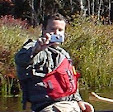 |
| Heading out under the Mount Hope Bridge |
I met Tony, Mike and Don at 10:30 at Bristol Ferry Town Common, a.k.a. Mount Hope Park. Before the completion of the Mount Hope Bridge, this was the site of a ferry between Portsmouth and Bristol. We would be paddling in Mount Hope Bay – an estuary at the mouth of the Taunton River that flows into the East Passage of Narragansett Bay and the Sakonnet River.
 |
| Founders Brook against the tide |
The Mount Hope Bridge connecting Portsmouth and Bristol is a 6,130-foot suspension bridge with a main span of 1,200 feet between piers. The deck is supported by two massive cables, each eleven inches in diameter, and 2,020-miles of wire. The Mount Hope Bridge was the first bridge not to be painted black. It was painted green to better fit into the surrounding scenery.
 |
| Hog Island Shoals Light |
Then we headed west under the Mount Hope Bridge and along the beach to a small saltwater inlet with great views of the Mount Hope Bridge and the Hog Island Shoals Lighthouse. The Hog Island Shoals Lighthouse was built in 1901 to protect ships from the rocky shoals around Hog Island. The lighthouse is now privately owned and the property is listed on the National Register of Historic Places.
 |
| Portsmouth Station |
After lunch we continued west out into the East Passage and down to the Carnegie Abbey Tower condominiums. This 22-story high-rise seems out of place in otherwise suburban Portsmouth. The complex is built on the site of the Kaiser Aluminum plant that fabricated aluminum and copper wire in the 1960’s and 1970’s. When that industrial complex was demolished in the 1990’s, this residential development was allowed to replace it at the same size and height.
We paddled into the marina that was part of the original Portsmouth Station. Built in 1855, Portsmouth Station was a critical piece of Rhode Island’s coal mining industry. In the early 19th century this area was the center of a vast network of mines crisscrossing the northeast of Aquidneck Island.
From there we headed back in light winds and easy waves to the put-in. Tony said my kayak stroke was looking more “kayaky” compared to the vertical, canoe-style stroke that I had when I paddled tandem with him at Fort Wetherill back in 2018. I took that as a compliment. We had a nice flotilla of sailboats come through just as we were leaving.
 |
| Sailboats under the bridge |
From there we headed back in light winds and easy waves to the put-in. Tony said my kayak stroke was looking more “kayaky” compared to the vertical, canoe-style stroke that I had when I paddled tandem with him at Fort Wetherill back in 2018. I took that as a compliment. We had a nice flotilla of sailboats come through just as we were leaving.
Links:











